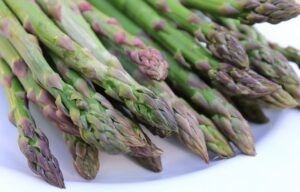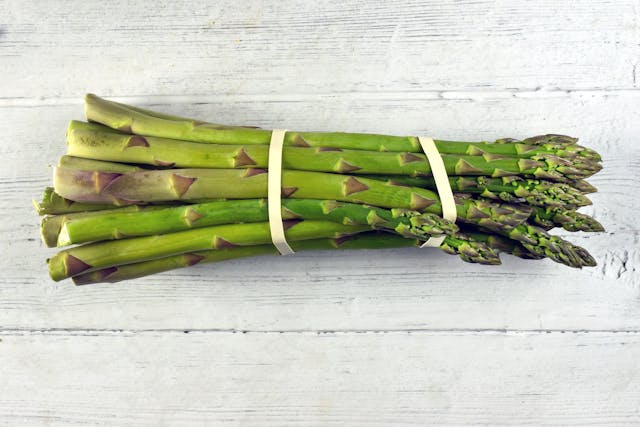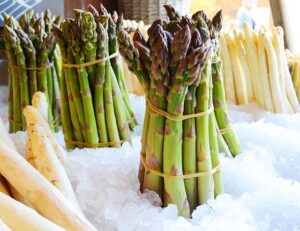A Unique Guide to Growing Asparagus at Home
Introduction
Have you ever imagined plucking fresh, crisp asparagus spears from your garden, ready to elevate your culinary?
Creations? Cultivating asparagus isn’t just about growing a vegetable; it’s about nurturing a tradition, a connection to the Land, and a celebration of the earth’s bounty. In this comprehensive guide, we delve into the art and science of growing Asparagus and unveil tips and tricks that will help you embark on your journey of homegrown goodness.
Understanding Asparagus
Asparagus, often dubbed the “queen of vegetables,” has a rich history dating back thousands of years. Originating in the eastern Mediterranean region, this perennial plant belongs to the lily family and comes in various cultivars, including green, purple, and white varieties. Not only is asparagus a nutritional powerhouse, packed with vitamins, minerals, and antioxidants, but it also boasts a unique flavour profile that adds depth and complexity to dishes ranging from soups to stir-fries.
Planning Asparagus in Your Garden
The key to a successful asparagus patch lies in thoughtful planning. Start by selecting a sunny location with well-drained soil, preferably with a pH level between 6.5 and 7.5. Consider creating raised beds or mounded rows to improve drainage and soil warmth, as asparagus thrives in loose, sandy loam. Companion planting with crops like tomatoes, parsley, and basil can enhance soil health and deter pests, creating a harmonious ecosystem in your garden.
Guide to Growing Asparagus Indoors and Outdoors
Outdoor Cultivation:
Outdoor cultivation of asparagus requires some planning and patience but rewards with bountiful harvests for years to come. Choose a sunny spot in your garden with well-drained soil and prepare the bed by removing weeds and incorporating organic matter. Asparagus thrives in slightly acidic to neutral soil pH levels, so a soil test may be beneficial to ensure optimal conditions.
Plant asparagus crowns in trenches approximately 6-8 inches deep and 12-18 inches apart, covering them with a few inches of soil initially. As the spears emerge, gradually fill in the trench, allowing them to grow into mature ferns. It’s essential to provide consistent moisture and weed regularly to promote healthy growth and prevent competition for nutrients.
Indoor Cultivation:
Limited outdoor space or harsh climates need not deter you from enjoying homegrown asparagus. Indoor cultivation offers a viable alternative, allowing you to savour the freshest spears without the constraints of traditional gardening. Begin by selecting a large container with drainage holes and filling it with a well-draining potting mix.
Choose a sunny window or provide supplemental lighting to ensure your asparagus receives adequate sunlight, ideally 6-8 hours per day. While indoor-grown asparagus may not produce as prolifically as its outdoor counterparts, it can still provide a satisfying harvest with proper care.
Planting Asparagus
When it comes to planting asparagus, patience is indeed a virtue. While seeds can be sown directly into the soil, most
home gardeners opt for crowns or transplants for quicker results. Choose disease-resistant, one-year-old crowns from reputable nurseries, ensuring they have healthy, fibrous roots. Plant your crowns in early spring, spacing them 18 inches apart in trenches that are 6-8 inches deep, and cover them with a few inches of soil. As the spears emerge, gradually fill in the trenches to encourage upward growth.

Nurturing Your Asparagus Patch
Watering is crucial during the early stages of asparagus growth, especially in dry climates or sandy soils. Aim to keep the soil consistently moist but not waterlogged, as excessive moisture can lead to rot and disease. Mulching with organic materials like straw or shredded leaves can help retain soil moisture, suppress weeds, and regulate soil temperature.
Asparagus is a heavy feeder, so consider applying a balanced fertilizer or compost in the spring and early summer to
promote robust growth and abundant yields.
Managing Asparagus Pests and Diseases:
Like any garden crop, asparagus is susceptible to pests and diseases, but with proper care, you can minimize their impact. Common pests include asparagus beetles, which feed on foliage, and aphids, which sap plant juices. Vigilant inspection and hand-picking can help control these pests, while natural predators like ladybugs and lacewings can provide biological control. As for diseases, proper sanitation, crop rotation, and avoiding overhead watering can prevent issues such as fusarium wilt and asparagus rust.
Harvesting and Enjoying Your Asparagus:
Patience is rewarded when it comes to harvesting asparagus, as young plants need time to establish their root systems before producing a substantial yield. Avoid harvesting during the first year to allow the plants to develop strength and vigour. In subsequent years, harvest spears when they reach 6-8 inches in height, snapping them off at ground level or cutting them with a sharp knife. Regular harvesting encourages continued production throughout the season while leaving some spears to mature allows the plants to store energy for the following year.
Continuing Care and Maintenance
Asparagus is an excellent long-term investment in your garden, with established beds that can produce bountiful harvests for up to 20 years or more. To maintain the health and productivity of your asparagus patch, it is essential to practice annual maintenance tasks such as pruning back foliage in the fall, applying a thick layer of mulch to protect crowns during winter, and replenishing soil nutrients with compost or organic fertilizers. Don’t forget to rotate crops every few years to prevent soil depletion and minimize pest and disease buildup

Conclusion
Growing asparagus is more than just a gardening activity; it’s a journey of patience, dedication, and culinary delight. By understanding the unique needs of this versatile vegetable and implementing best practices for cultivation and care, you can reap the rewards of a thriving asparagus patch for years to come. So roll up your sleeves, dig in the dirt, and savour the satisfaction of nurturing nature’s bounty right in your backyard.
Closing Thoughts
Whether you’re a seasoned gardener or a novice enthusiast, cultivating asparagus offers a gratifying experience that
connects you to the rhythms of the natural world. So embrace the challenge, relish the process, and enjoy the fruits (or rather, spears) of your labour as you embark on this flavorful adventure in home grow


